
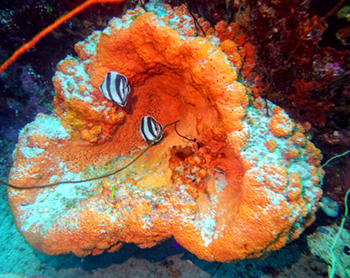
On a quiet beach fronting a turquoise sea, we approached a lone food truck run by a young family and ordered lunch: salads topped with tuna. Apologies, the mom said, it's not available because the fisherman hasn't come yet today.
As we perused alternatives on the chalkboard menu of Kite City, the fisherman arrived with just-caught tuna. In a few minutes, we were digging into porcelain bowls filled to the brim with fresh salad and seared, scrumptious fish. And we weren't expected to pay until we had finished eating and returned the bowls.
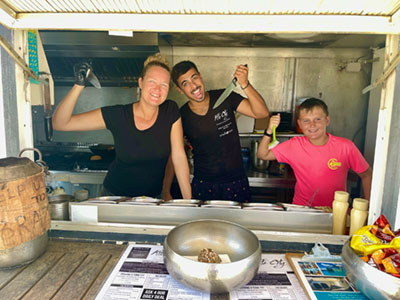
In a nutshell, that's why we loved Bonaire. Everyone and everything seemed nice, straightforward, authentic and safe. People we didn't know treated us like friends; a few visits later, they treated us like relatives. Even interactions in businesses from restaurants to banks felt like we were dropping by to see a beloved aunt. Travelers and locals alike were laid-back. Food was outstanding. Honesty abounded. Sunsets were spectacular. And under the tides, a panorama unfolded.
Unlike crowded tropics clogged with chain hotels, rugged Bonaire - home to 24,000 people - is a desert island with an inviting, small-town air. It's not surrounded by a coral reef – it is coral, which makes Bonaire one of the top scuba diving and snorkeling spots on the planet.
About 50 miles off the coast of Venezuela, Bonaire is the eastern-most and least developed of the ABC chain, typically known for flashier Aruba and Curacao. Iguanas and geckos are ubiquitous, flamingoes are common and wild donkeys roam at will.

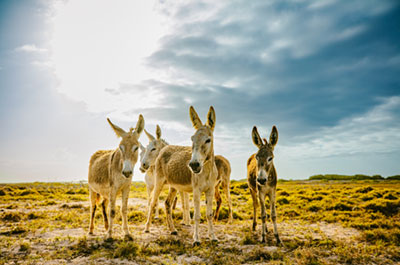
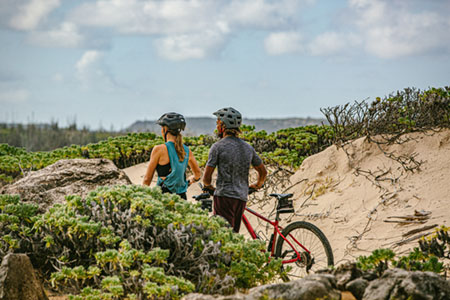
With its reliably sunny climate, temperatures in the 80s and little rain, Bonaire is all about peaceful adventure – mostly focused on the stunning seas. Its 60 dive sites (with 26 more on the neighboring uninhabited islet of Klein Bonaire) are all well-marked and many of them can be reached from shore. In addition to diving and snorkeling, the aquatic action includes kayaking, windsurfing, kiteboarding, boating, swimming and fishing.
Unless you're an avid explorer of marine life, odds are you haven't heard of Bonaire. And that's a good thing for those who do find their way there. Snugly situated outside the hurricane belt, this is a dream destination...a compact one with not a single traffic light.
Bonaire is just 111 square miles with a width of 3 to 7 miles and a length of 24 miles. You can travel the whole thing in a day by moped, motorcycle, car or, perhaps, bicycle. With mostly cacti and scraggly shrubs for landscaping, Bonaire may be likened to the Arizona outback, but the island is buffeted by strong trade winds, which provide almost constant breezes.
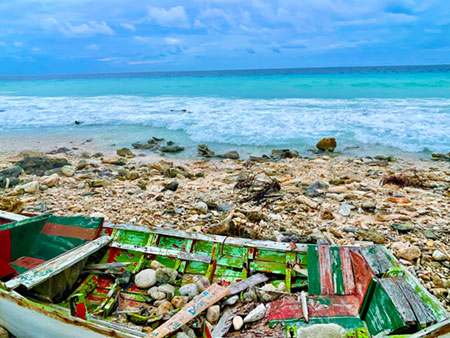
The bliss beneath the sea is so prized that sustainable tourism took hold before there was a term for it. Bonaire boasts the Caribbean's oldest and largest ocean sanctuary – essentially, its entire perimeter. In 1961, environmental awareness began with the protection of turtles. Ten years later, spear fishing was prohibited. In 1979, the National Marine Park was created.
Today, the anchoring of boats is limited, and there's a coral restoration program that's a model for the rest of the Caribbean. In addition, every place we visited offered refillable glass jugs because there's virtually no plastic bottles. The desalinated tap water tastes way better than the H2O in the United States.
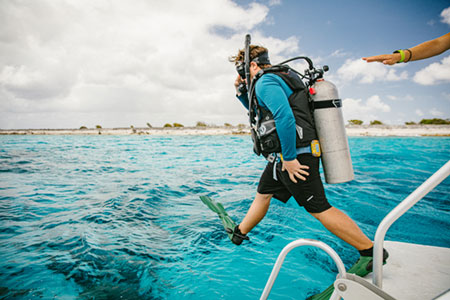
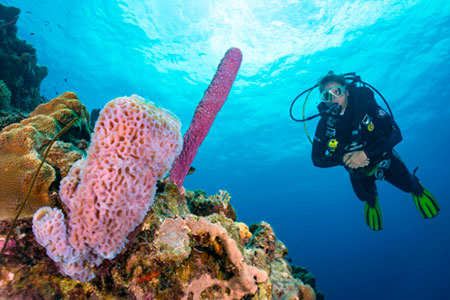
Welcome to Wonderland
We were met at Flamingo International Airport by a beat-up truck driven by the daughter of a European woman who owns the no-frills Tropical Divers Resort. We had secured reservations for our first few nights in the month-long festival of Carnival, which attracts tourists to its parades and parties.
After checking into our clean, minimalistic room, we set out in search of dinner by walking across the dusty road to the Plaza hotel (no relation to the ritzy one in New York City).
The guard at the gate said the hotel's dining room was open to only guests due to high occupancy, so we asked if he would call a taxi to take us to the nearest eatery. As he reached for his phone, a mini car with two young women bounced toward the gate from the hotel.
The guard stopped them, speaking in the local language, Papiamento. (Dutch is the official tongue, but English and Spanish are taught in school, too.) Then he told us in halting English: "They'll drive you to the restaurant." Setting aside our urban wariness, we hoped in.
Happily chatting with us in English, the women detoured off their route and took us to a nearby Chinese restaurant, but it was closed. They drove another 10 minutes to the main street in town and dropped us at a distinctive Peruvian eatery, Tasty Steakhouse, that they often frequented.
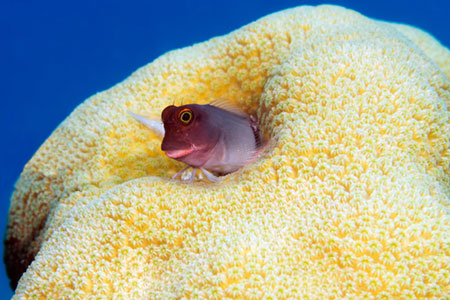
Island Treasures
"Bon dia!" boomed Rolando Marin, a native who works for the island's tourism bureau, when we met to be shown around.
Rolando's initial stop: The low-key Te Amo beach, conveniently located next to the small airport, which provides easy access for snorkeling. With just mask, fins and snorkel, we slipped into the shallow surf, where a rainbow of fish flitted by, including sunny yellow and blue damselfish, parrotfish, butterflyfish, black and yellow Creole wrasses, and orange spotted filefish. As we floated in the warmth, coral gently swaying, time seemed to stand still.
More than 50 species of coral are here, along with more than 400 species of fish as well as sea turtles and dolphins. Due to ocean warming, some of the once-colorful coral – especially closest to shore - has been bleached a ghostly white. But this is a global problem. At least here, the fish still dazzle in electric colors and patterns.
There were plenty of attractions on land, too. Next stop: The vibrant capital and main port of Kralendijk (pronounced KRAWL-in-dike), which means "coral dike" in Dutch. The town is easily checked out on foot, perhaps stopping for an iced coffee at a shop along the wharf to eye the surf and seagulls.



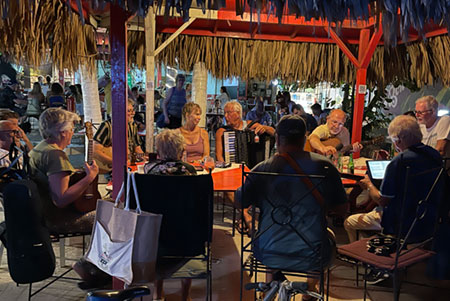
During our stay, we discovered in Kralendijk a delish variety of international cuisine (more on that later) and delightful shops, including Beach Vibes, which produced original, au courant bracelets at modest prices. We strolled the pleasant streets, and we frequented the arts and crafts market near the docks, the farmers' market near the grocery stores, and the limited night spots (a few bars that stayed open late), never once worrying about our security. Even the big, raucous parades for Carnival were an exhilarating tribute to community and fun.
Rolando's girlfriend, Chicago-born Susan Davis, is a noted bird expert who provides tours of the rich avian life on the island. There are more than 100 types, including pink flamingos, Amazon parrots, herons, doves, pelicans, sandpipers, plovers, sanderling and ospreys, and Rolando was able to point out quite a few.
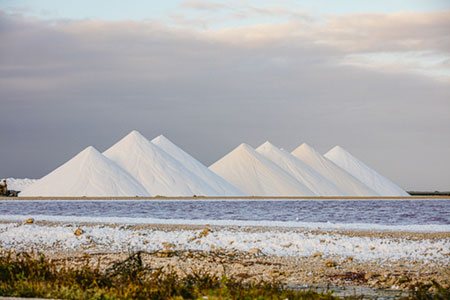
Mountains of salt.
Driving South and North
Rolando motored to the southern part of the island, which showcases the Willemstoren Lighthouse, built in 1857, as well as Lac Bay, an excellent spot for windsurfing, and a flamingo sanctuary.
The biggest shockers were mammoth mountains of salt surrounded by sparkling pink and white salt "pans," shallow lagoons of evaporating seawater once worked by enslaved people under inhuman circumstances. Short, stone huts from the 1850s that housed the slaves still line the beach in their memory.
The salt operation is now controlled by Cargill, the American agri-giant. Rolando showed us a huge crate of salt chunks, free for the taking. We picked up a chunk; one lick told us it was the most complex salt we'd ever tasted.
Rolando then drove north toward the island's second-biggest town, Rincon, which dates to the 16th century. On the way, he paused at a pristine beach called 1,000 Steps that's reached via limestone stairs.
Sleepy Rincon is near the entrance of Washington Slagbaai National Park, which takes up 20 percent of the island. The stark desolation of its 14,000 acres is edged by the glittering sea; here, too, aqua activities are the focus.
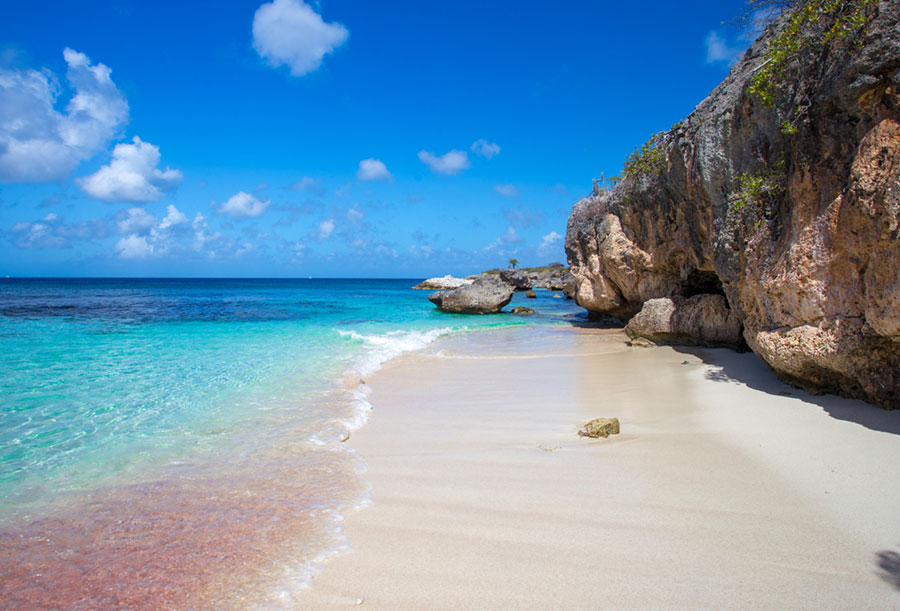
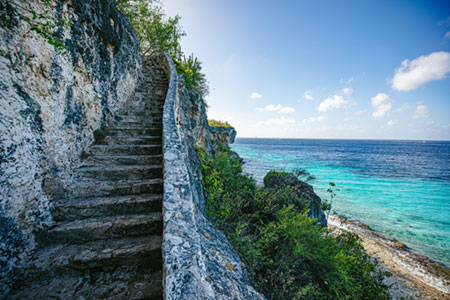
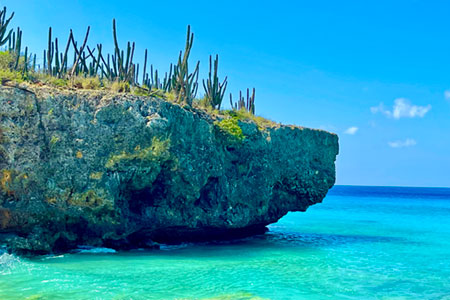
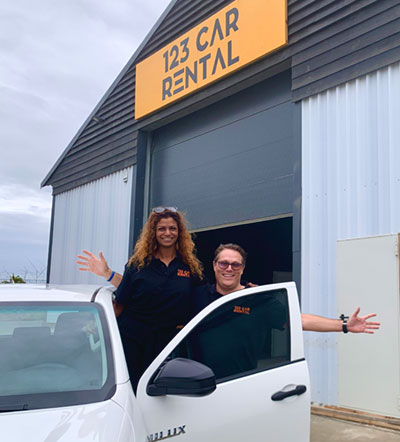
Rincon is also home to the Cadushy Distillery, which bottles the world's only liqueur made from cactus. We stopped by to sample island versions of rum, vodka, gin and blue curacao. The area is also recognized for serving up the best indigenous food, such as goat or iguana stews.
Back on our own the next day, we arranged to get a vehicle from 123 Car Rental, another family concern that did business with a smile. Taxis are available only if you call and there's no Uber, Lyft or public transportation, so ease of movement dictated having our own wheels. The roads are rarely smooth, so those wheels were on a truck.
The company promises hassle-free rental, and that's what we got. The couple who owns the agency were happy to pick us up and drop us off, graciously pouring coffee whenever we arrived at their office.
We headed to more spots of interest, such as the drive-through Donkey Sanctuary, which takes care of 700 burros, whose ancestors were brought to Bonaire by Dutch settlers. And we went to places of necessity, such as the Caribbean Laundry, which offers the only laundromat on the island, and the grocery, where we bought our provisions for most breakfasts and lunches.
Places to Eat
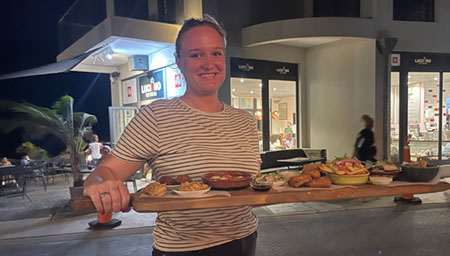
Bonaire boasts a surprisingly dynamic culinary scene, much of it at al fresco venues, from Asian fusion to high-end chef's tables. We never ate a bad meal.
Among our faves: Karel's Beach Bar, where we sat at the end of a large platform overlooking the sea; It Rains Fishes, an upscale deep dive into seafood; and El Pescado, whose outdoor tables provided a pretty view of the docks while we inhaled the Seacuterie platter and other creations of Adriana, a local chef.
We weren't able to stay at the oceanfront Harbour Village Beach Club with its four acres of sand (prized because most beaches are rocky), pool and marina, dotted with hammocks and palm trees. But we did eat both lunch and dinner at its luxe restaurant, La Balandra, built on a pier over the ocean. At midday, we tucked into an amazing poke bowl of sushi rice, sweet and sour veggies, edamame and wakame with tenderloin tataki. At night, we aahed over jumbo Thai prawns in red coconut curry sauce as we watched schools of large, silver tarpon swim past.
Ingridients, named after chef Ingrid, is the signature waterfront restaurant at one hotel where we stayed, Buddy Dive Resort. It featured Mediterranean dishes in a menu that changed daily. Also at the hotel was Blennies, a rustic yet lovely eatery with tables directly on the sand, where we went crazy for the appetizing all-you-can-eat barbecue, a weekly special.
For casual fare, in addition to Kite City, we frequented the Stoked food truck on the beach; the hyper-local Social Café, where we drooled over garlic shrimp, red snapper, plantains and sides of "tutu" (prepared with cornmeal, butter, garlic, black-eyed peas, onions, nutmeg, and coconut milk) and "funghi" (cornmeal, salt and butter); and Gio's Gelateria & Caffee, where blended coffee drinks, gelato and air conditioning ruled the day...and night.
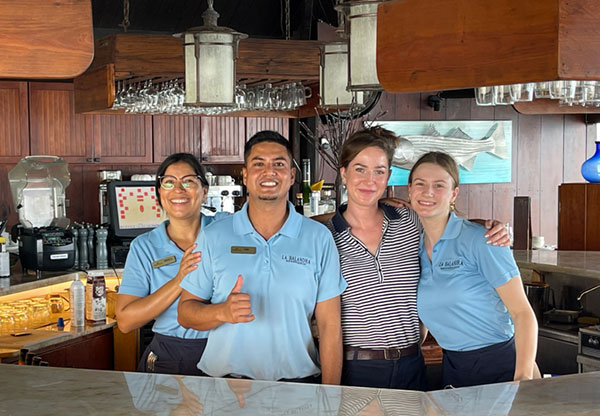

For casual fare, in addition to Kite City, we frequented the Stoked food truck on the beach; the hyper-local Social Café, where we drooled over garlic shrimp, red snapper, plantains and sides of "tutu" (prepared with cornmeal, butter, garlic, black-eyed peas, onions, nutmeg, and coconut milk) and "funghi" (cornmeal, salt and butter); and Gio's Gelateria & Caffee, where blended coffee drinks, gelato and air conditioning ruled the day...and night.
Places to Sleep
Bonaire offers many lodging choices up and down the price scale, including hotels, motels, rentals and AirBNB spaces. Virtually all of the hotels have either an on-site diving operation or are affiliated with one nearby. With space at a premium due to Carnival, we spent a few days each at two more hotels.
The Windhoek Resort, a cozy boutique property designed with natural flair by a well-known Dutch architect, made for a cushy stay. It was developed by a windsurfing champ and his wife. Each one- and two-bedroom villa includes a large bathroom with a rain shower, a kitchen and a four-poster bed.
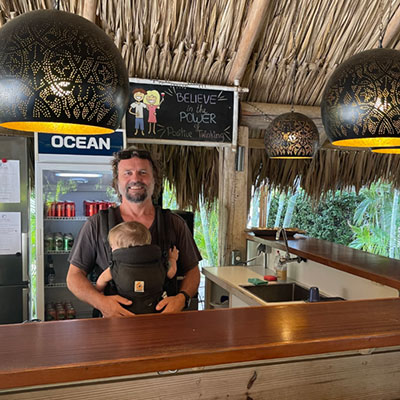

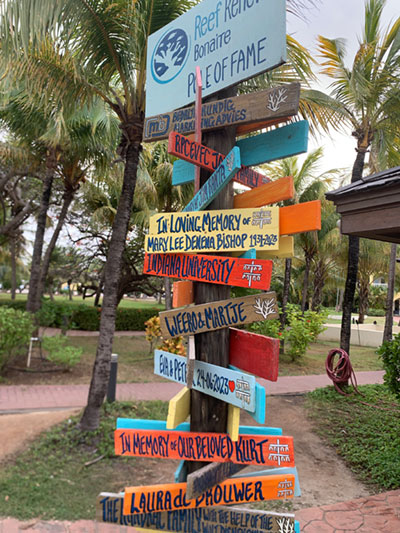
We were swimming in the Windhoek's deep, gorgeous pool when an iguana jumped in. All the other humans jumped out, but we tried to catch the iguana so we could put it back on land. While we were secretly congratulating ourselves on our relative bravery, a local told us these are carnivorous lizards...that bite. We joined the others outside the pool.
At Buddy Dive Resort, most guests have signed up for a package complete with lodging, dining, diving and, even, car rental. We occupied an ocean-view room with a bedroom, living room and kitchen, where we cooked the catch we had bought in town from a fisherman.
We learned about Buddy Dive's leadership in the Reef Renewal Project, which establishes coral nurseries to further the recovery of Bonaire's reefs. Our leisure activity here was uncomplicated and beautiful: With mask, fins and snorkel in hand, we walked down a ladder and glided into the sea.
A Last Word About Diving
While there are many dive resorts and dive boats in Bonaire, the truth is you can fall into the ocean just about anywhere for an up close and personal look at fishy residents. There's little current and lots of crystal-clear visibility.
Each diver who comes to Bonaire must pay a nature fee (the American dollar is the official currency), take a class covering a set of strict rules and go on an orientation dive. Many underwater aficionados return year after year.
While diving with the scuba operation Dive Friends, we spotted queen angelfish, blue angelfish, moray eels, scorpionfish, balloon fish, hawksbill turtles, barracudas, octopus, honeycomb cowfish and blue tang as well as pods of dolphins.
Everywhere we went, we saw divers and snorkelers in full gear. Makes sense: It has been said that the whole island is one big dive site.
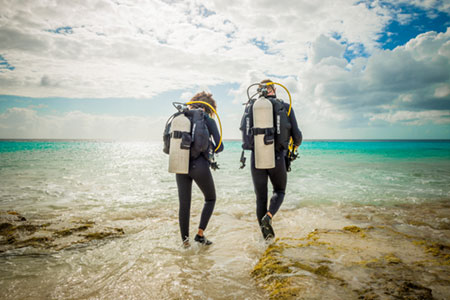
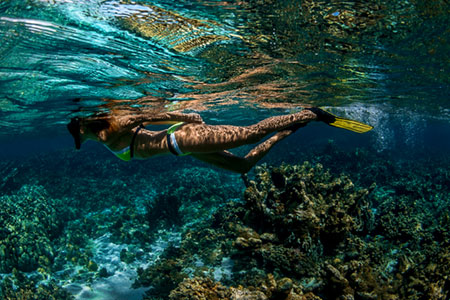
Meanwhile, Back in N.C.
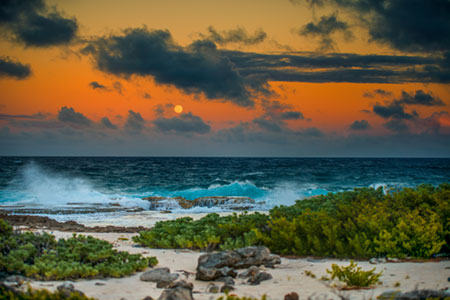
After our return, we were repeatedly asked if we'd recommend a trip to this isle to those who don't dive or snorkel. Bottom line: Bonaire is not for everybody. The days are gentle and genial, long and leisurely. But if it is right for you, Bonaire is extraordinary.